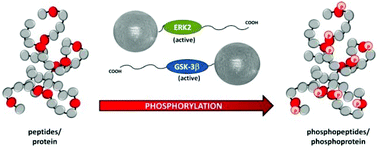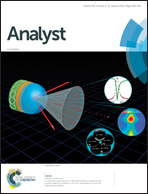Kinase-loaded magnetic beads for sequential in vitro phosphorylation of peptides and proteins†
Abstract
Post-translational modifications, including phosphorylation, greatly impact the physiological function of proteins, especially those that are natively unfolded and implicated in many neurodegenerative diseases. However, structural and functional studies of such proteins require fully defined phosphorylation, including those that are not physiological. Thus, the kinases ERK2 and GSK-3β were immobilized to various superparamagnetic beads with carboxylic, aldehyde, Ni2+, or Co3+ functional groups, with a view to efficiently phosphorylate peptides and proteins in vitro. Full phosphorylation of specific synthetic peptides confirmed that beads were successfully loaded with kinases. Remarkably, enzymes covalently immobilized on carboxylated SeraMag beads remained active upon reuse, with residual activity after 10 uses 99.5 ± 0.34% for GSK-3β and 36.2 ± 2.01% for ERK2. The beads were also used to sequentially phosphorylate recombinant tau, which in vivo is a biomarker of Alzheimer's disease. Thus, a system consisting of two fully active kinases immobilized to magnetic beads is demonstrated for the first time. In comparison to soluble enzymes, the beads are easier to handle, reusable, and thus low-cost. Importantly, these beads are also convenient to remove from reactions to minimize contamination of phosphorylated products or to exchange with other kinases.



 Please wait while we load your content...
Please wait while we load your content...